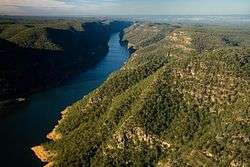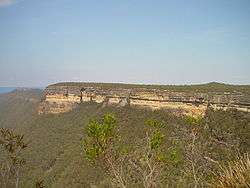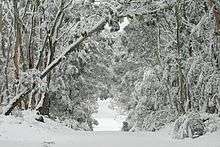Greater Blue Mountains Area
| Greater Blue Mountains Area | |
|---|---|
| Name as inscribed on the World Heritage List | |
|
A view over Jamison Valley, in 2008. | |
| Location | Blue Mountains region, New South Wales, Australia |
| Type | Natural |
| Criteria | ix, x |
| Reference | 917 |
| UNESCO region | Asia-Pacific |
| Coordinates | 33°42′S 150°0′E / 33.700°S 150.000°ECoordinates: 33°42′S 150°0′E / 33.700°S 150.000°E |
| Inscription history | |
| Inscription | 2000 (24th Session) |
 Location of the Blue Mountains on the Australian continent | |
The Greater Blue Mountains Area is a World Heritage Site in the Blue Mountains of New South Wales, Australia. The 1,032,649-hectare (2,551,730-acre) area was inscribed on the World Heritage List at the 24th Session of the World Heritage Committee, held in Cairns in 2000 with the following inscription:[1]
...a deeply incised sandstone tableland that encompasses 1.03 million hectares of eucalypt-dominated landscape just inland from Sydney, Australia’s largest city, in south-eastern Australia. Spread across eight adjacent conservation reserves, it constitutes one of the largest and most intact tracts of protected bushland in Australia. It also supports an exceptional representation of the taxonomic, physiognomic and ecological diversity that eucalypts have developed: an outstanding illustration of the evolution of plant life. A number of rare and endemic taxa, including relict flora such as the Wollemi pine, also occur here. Ongoing research continues to reveal the rich scientific value of the area as more species are discovered.The geology and geomorphology of the property, which includes 300 metre cliffs, slot canyons and waterfalls, provides the physical conditions and visual backdrop to support these outstanding biological values. The property includes large areas of accessible wilderness in close proximity to 4.5 million people. Its exceptional biodiversity values are complemented by numerous others, including indigenous and post-European-settlement cultural values, geodiversity, water production, wilderness, recreation and natural beauty.
Description
This area is one of rugged tablelands, sheer cliffs, deep, inaccessible valleys and rivers and lakes teeming with life. The rare plants and animals that live in this natural place relate an extraordinary story of Australia's antiquity, its diversity of life. This is the story of the evolution of Australia's unique eucalypt vegetation and its associated communities, plants and animals.
The Greater Blue Mountains Area consists of 10,300 square kilometres (4,000 sq mi) of mostly forested landscape on a sandstone plateau 60 to 180 kilometres (37 to 112 mi) inland from the Sydney central business district.[2] The area includes vast expanses of wilderness and is equivalent in area to almost one third of Belgium, or twice the size of Brunei.
The area is called "Blue Mountains" based on the fact that when atmospheric temperature rise, the essential oil of various eucalyptus species evaporates and disperse in the air, then visible blue spectrum of sunlight propagates more than other colours. Therefore, the reflected landscape from mountains seems bluish by human eyes.[3]
The property, which includes eight protected areas in two blocks separated by a transportation and urban development corridor, is made up of seven outstanding national parks as well as the famous Jenolan Caves Karst Conservation Reserve. These are the Blue Mountains National Park, Wollemi National Park, Yengo National Park, Nattai National Park, Kanangra-Boyd National Park, Gardens of Stone National Park and Thirlmere Lakes National Park.
The area does not contain mountains in the conventional sense but is described as a deeply incised sandstone plateau rising from less than 100 metres (330 ft) above sea level to 1,300 metres (4,300 ft) at the highest point. There are basalt outcrops on the higher ridges. This plateau is thought to have enabled the survival of a rich diversity of plant and animal life by providing a refuge from climatic changes during recent geological history. It is particularly noted for its wide and balanced representation of eucalypt habitats from wet and dry sclerophyll, mallee heathlands, as well as localised swamps, wetlands, and grassland. Ninety-one species of eucalypts (thirteen percent of the global total) occur in the Greater Blue Mountains Area. Twelve of these are believed to occur only in the Sydney sandstone region.
Vegetation
-

Three Sisters, Blue Mountains National Park
-

Lake Burragorang
-

Kanangra Walls at Kanangra-Boyd National Park
-
Forest near Boyd River
-

Boyd River campground in winter (Kanangra-Boyd National Park)
The area has been described as a natural laboratory for studying the evolution of the eucalypts. The largest area of high diversity of eucalypts on the continent is located in south-east Australia. The Greater Blue Mountains Area includes much of this eucalypt diversity.
As well as supporting such a significant proportion of the world's eucalypt species, the area provides examples of the range of structural adaptations of the eucalypts to Australian environments. These vary from tall forests at the margins or rainforest in the deep valleys, through open forests and woodlands, to shrublands of stunted mallees on the exposed tablelands.
In addition to its outstanding eucalypts, the Greater Blue Mountains Area also contains ancient, relict species of global significance. The most famous of these is the recently discovered Wollemi pine, a "living fossil" dating back to the age of the dinosaurs. Thought to have been extinct for millions of years, the few surviving trees of this ancient species are known only from three small populations located in remote, inaccessible gorges within the area. The Wollemi pine is one of the world's rarest species.
Fauna
-

A dingo at Yengo National Park
-
.jpg)
Red-necked wallaby in the Blue Mountains
More than 400 different kinds of animals live within the rugged gorges and tablelands of the Greater Blue Mountains Area. These include threatened or rare species of conservation significance, such as the tiger quoll, the koala, the yellow-bellied glider and the long-nosed potoroo as well as rare reptiles and amphibians including the green and golden bell frog and the Blue Mountain water skink.
The largest predator of the area is the dingo. These wild dogs hunt for grey kangaroos and other prey.[4]
The greater Blue Mountains region has been identified by BirdLife International as an Important Bird Area (IBA) because it supports a high proportion of the global populations of the range-restricted rockwarbler as well as populations of flame robins, diamond firetails and pilotbirds. The endangered regent honeyeater is seen there regularly. It is also a migration bottleneck for yellow-faced honeyeaters.[5]
UNESCO listing
The Greater Blue Mountains Area was unanimously listed as a World Heritage Area by UNESCO on 29 November 2000. It thus became the fourth area in New South Wales to be listed.[6] The area totals roughly 10,300 square kilometres (4,000 sq mi), including the Blue Mountains, Kanangra-Boyd, Wollemi, Gardens of Stone, Yengo, Nattai and Thirlmere Lakes National Parks, plus the Jenolan Caves Karst Conservation Reserve. A buffer zone of 86,200 hectares (213,000 acres) lies outside the protected area.[1]
The reason why this site was chosen to be included on the World Heritage list is quoted below:
| “ | "Criteria (iii) and (v): Australia’s eucalypt vegetation is worthy of recognition as of outstanding universal value, because of its adaptability and evolution in post-Gondwana isolation. The site contains a wide and balanced representation of eucalypt habitats from wet and dry sclerophyll, mallee heathlands, as well as localised swamps, wetlands, and grassland. 90 eucalypti tax (13% of the global total) and representation of all four groups of eucalypts occur. There is also a high level of endemism with 114 endemic taxa found in the area as well as 120 nationally rare and threatened plant tax. The site hosts several evolutionary relic species (Wollemia, Microstrobos, Acrophyllum) which have persisted in highly restricted micro sites." | ” |
References
- 1 2 "Greater Blue Mountains Area". World Heritage List. UNESCO. 2014. Retrieved 31 August 2014.
- ↑ "Blue Mountains". Visit NSW. Retrieved 11 June 2013.
- ↑ Greater Blue Mountains Area(世界遺産の旅、世界遺産ライブラリー), NHK library, World Heritage Site (Japanese) Retrieved on 16 July 2008.
- ↑ Brad V. Purcell: A novel observation of dingoes (Canis lupus dingo) attacking a swimming eastern grey kangaroo (Macropus giganteus). Australian Mammalogy 32(2) 201–204, 2010.online Abstract
- ↑ "IBA: Greater Blue Mountains". Birdata. Birds Australia. Retrieved 2011-06-29.
- ↑ Gardens of Stone National Park Information Sheet, National Parks and Wildlife Service of New South Wales, October 2001
External links
| Wikimedia Commons has media related to Blue Mountains, New South Wales. |
- Blue Mountains virtual video tour.
- Nomination of the Greater Blue Mountains Area for inscription on the World Heritage List by the Government of Australia 1998
- Greater Blue Mountains Area at UNESCO World Heritage Centre
- Blue Mountains World Heritage Institute
- Blue Mountains, NSW, Australia Aerial video of the Jamison Valley below Katoomba.

.jpg)